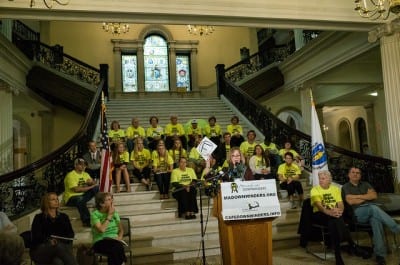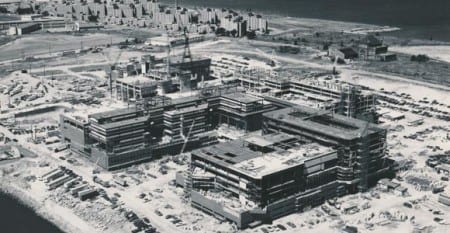
Global warming will flood Boston. Why not move the state capital to Worcester?
May 26, 2018
BY JASON PRAMAS @JASONPRAMAS
Many small American cities have boosterish metro research organizations that look like a cross between a public policy outfit and a chamber of commerce, and the Bay State’s second biggest urban area is no exception. The Worcester Regional Research Bureau (WRRB) was founded in 1985 during a period when all of Massachusetts’ major cities were facing a funding crisis caused by the tax-slashing Proposition 2 1/2 and needed to find ways to keep their local economies functioning with less funding from state government. Since that time, according to its website, the “Research Bureau has prepared over 220 reports and held over 200 forums on topics including public administration, municipal finance, economic development, education, and public safety.” Its board is like a who’s who of the Worcester power structure.
In March, WRRB released a 10-page report, “Brokering a New Lease: Capturing the Value of State Offices for Massachusetts.” Not exactly the kind of title that’s going to inspire headlines, and it didn’t—only receiving coverage in the Worcester Business Journal and Commonwealth magazine. But the white paper actually makes an interesting point: Why are the headquarters of the many state agencies mainly in the Hub?
Boston has very expensive real estate prices. And even though the state owns some office buildings around town, many agencies lease commercial space for their headquarters. So, WRRB reasons, wouldn’t it make good sense to move some of those HQs to Worcester? Saving the Commonwealth money, and helping the Worcester economy with lots of decent state jobs in the process?
Consider that, according to the report, Class A office space in Boston was running as high as $60.85 per square foot in 2017. It then points out that the “state pays an average of $37 per square foot across its Boston lease agreements, with a high of $73 per square foot near Boston City Hall and a low of $19 per square foot in Hyde Park.”
Meanwhile, “Brokering a New Lease” continues: “The [WRRB] consulted the City’s Economic Development Office and local real estate brokers and identified 275,000 square feet of available space across eight buildings that could feasibly house a state office. … The average rent was $21.31 per square foot, and one local broker said $22 per square foot would be a reasonable minimum estimate for new leases involving capital investment.”
A savings of $15 per square foot on average—which translates to my back-of-the-envelope estimate of $4,125,000 a year that would stay in the Commonwealth’s coffers—is nothing to sneeze at. It’s true that removing 275,000 square feet of the 1,675,806 square feet that the state currently has under lease in Boston, according to the report, would mean that the Hub stands to lose 16.4 percent of its state office space. Not an inconsiderable economic hit for Boston’s commercial real estate market, and something WRRB staff do not seem to be concerned about. But Worcester’s gains would potentially offset Boston’s losses from such a deal, when considering the state economy in its entirety.
Which makes the report’s rationale for moving some agency offices sound reasonable on cost-benefit grounds alone—although I can understand why many state employees might not want to move from more cosmopolitan Boston to a city with less social and cultural opportunities on offer. On the other hand, with a significantly lower cost of living, state salaries will stretch a lot further in Worcester County. To the point of allowing low-level bureaucrats, who couldn’t dream of buying so much as a condo in Boston these days, to buy a house out there.
But what interests me about the report is not so much its original subject as something I’m sure that WRRB staff hasn’t yet given the slightest thought. Over the last few years, I’ve written numerous columns and editorials sounding the alarm about what I feel is Boston’s woefully inadequate preparations for the several major global warming-induced crises that scientists expect coastal cities to endure in the coming decades. One of the most dangerous of those is sea level rise. Much of Boston is low-lying former wetlands, and unless we start building major harbor-wide flood defenses soon, we don’t have a prayer of slowing the Atlantic Ocean’s reclamation of those areas. And doing grave damage to critical systems like power, transportation, and sewage in the process.
Even if Boston does build huge dikes, and make other needed changes to the city design, it’s only a matter of time before the ocean wins. Since sea levels are expected to continue to rise for hundreds of years until, potentially, all of Earth’s major land-based ice sheets have melted into the ocean.
So why not move the state capital to Worcester—a city whose elevation is 480 feet—in stages? Starting with getting state agencies out to the city appropriately nicknamed the “Heart of the Commonwealth” in the manner the WRRB suggests. Then building the bullet train to Boston that former gubernatorial candidate Setti Warren is so excited about. And gradually transferring more and more of state government to the “City of Seven Hills” (the place really has a lot of nicknames). Until, eventually, we move the State House itself.
In addition to helping state government better weather global warming, having our capital in the middle of the state could go a long way toward healing the many divisions between eastern and western Massachusetts.
Don’t get me wrong; this is not the kind of proposal I’d make if we weren’t facing climate change dire enough to threaten the survival of the human race. But we are. Not today. Not tomorrow. Someday soon, though. We’re already seeing signs and portents now in the increasingly frequent “wild weather” that dishonest meteorologists like to prattle on about on Fox and its ilk. Including Worcester becoming more of a tornado alley than it already was—something I don’t think is nearly as much of a threat as the anticipated 10 feet of sea level rise Boston is facing by century’s end. More, if the land-based Greenland and Antarctic ice sheets start sliding into the ocean faster than the majority of climate scientists are currently projecting.
In past writing, I’ve suggested moving critical Boston infrastructure to the hills in and around the city. We will still need to do that. But growing Worcester while shrinking Boston is another smart move to consider. And why stop at just moving the state government? Why keep the city’s population exposed to ever more fierce hurricane- and winter storm-driven flooding when we can gradually move to a nearby city that could absorb quite a lot of our population before reaching capacity? A city acceptably far from the sea and major river systems, and high enough to not have to worry about being permanently flooded out (except, perhaps, in the worst possible scenarios).
Anyhow, food for thought. I’d be curious to hear what the WRRB staff—and other policy wonks and urban planners in “Wormtown” (loving these nicknames)—think about my proposal. I make it in earnest, and hope it is taken in the spirit with which I offer it. They can reach me, as ever, at jason@digboston.com.
Townie (a worm’s eye [ironic, no?] view of the Mass power structure) is syndicated by the Boston Institute for Nonprofit Journalism. Jason Pramas is BINJ’s network director, and executive editor and associate publisher of DigBoston. Copyright 2018 Jason Pramas. Licensed for use by the Boston Institute for Nonprofit Journalism and media outlets in its network.





